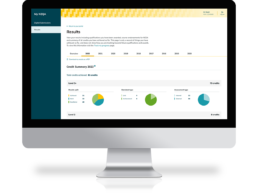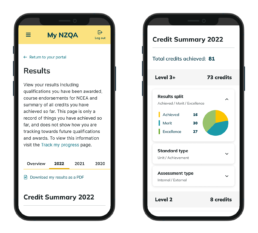Project overview
The primary goal of the Customer Experience Improvement Programme (CxIP) initiative was to transform NZQA’s digital channels, enhancing their capability to offer targeted, personalised services through their website and secure portals. This transformation aimed to significantly improve user experience and satisfaction for learners, schools, and tertiary education providers alike.
As part of the (CxIP), NZQA delivered personalised services through secure portals for learners, schools, and tertiary providers. This was a highly intricate project involving multiple stakeholders and three different product owners . As part of a team of three UI/UX designers my role was to enhance user interfaces and ensure smooth user experience across three distinct areas: the learners portal, schools portal and tertiary providers portal, as well the integration between these platforms.
Designed and enhanced user interfaces, ensuring smooth user experience across different areas of the CixP program.
Challenges
Throughout the project, I collaborated closely with all three product owners, ensuring that the design solutions met the specific needs and expectations of each stakeholder group. Our focus was on creating intuitive interfaces that streamlined access to teachers, learners and providers information, assessment tools, and administrative functions amongst other.
Managing stakeholder expectations: Balancing the diverse requirements of three different product owners and multiple stakeholders posed a significant challenge. Clear communication and regular demonstrations of high fidelity prototypes helped align expectations and foster collaboration, as well as creating opportunities for improvement.
Handling complex information and requirements: Simplifying the presentation of complex information without sacrificing clarity required innovative interface design solutions. Iterative testing and refinement were crucial in achieving a balance between usability and content delivery.
Approach
Agile methodology: Working on a Agile setting, receiving user goals as requirements from stakeholders and product owners and breaking them down into manageable tasks. This iterative process allowed us to respond flexibly to evolving needs and incorporate feedback at each stage of the design.
User-centered design: Extensive user research was conducted to understand the processes and pain points of students and school teachers. This included interviews, surveys, and observational studies to gather insights into their workflows and preferences.
Prototyping and iterative Design: Using the gathered insights, we developed high-fidelity prototypes to visualise proposed solutions. These prototypes were refined through multiple iterations based on feedback from usability testing sessions with students and school teachers. This iterative approach ensured that our designs not only met stakeholder requirements but also effectively supported user workflows.
Usability testing: Rigorous usability testing was conducted to validate design decisions and ensure that the interfaces were intuitive and effective. Testing sessions with students and school teachers provided valuable feedback on navigation, information clarity, and functionality, which guided further refinements.
Design Reviews: Regular design reviews were conducted to ensure that developers implemented designs as intended. This process involved collaborating closely with development teams, providing feedback and addressing any discrepancies to maintain design consistency and quality.
Feedback
The collaborative efforts within an Agile framework, combined with robust user-centered design practices, resulted in successful transformations of NZQA’s digital portals.
The updated interfaces now offer intuitive navigation, personalised experiences and streamlined access to the required information for learners, schools, and tertiary providers.
Early feedback from stakeholders and initial users has been promising, emphasising the improved ease of use and accessibility of the updated portals. Users have appreciated the intuitive navigation and personalised features, indicating positive reception to the ongoing enhancements.




